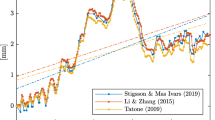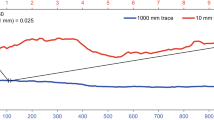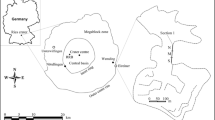Abstract
The purpose of this paper is to present an extensive evaluation of the methods to calculate the fractal dimension of natural fracture surfaces. Three methods; variogram analysis (VA), power spectral density (PSD), and roughness-length method (RMS) are applied to 2-D surface data (PSD) and 1-D profiles (VA and RMS) extracted from the surface data of 54 mm diameter crystallized limestone samples. Surface topography of the samples is quantified through a newly designed fully automated device. Before the application, self-affinity of the surface roughness and the applicability of these methods are validated using synthetically generated fractal surfaces. Fractal dimension values of the profiles are obtained as between 1 and 1.5 with a few exceptions. VA and RMS methods yield consistent fractal dimensions while the PSD values are lower than those of the other two methods. In terms of practical applicability, the VA is found more convenient than other two methods because there still exists shortcomings with the PSD and RMS methods due to difficulties in the mathematical analysis of the plots whose slopes are used in the computation of fractal dimension. However, it is observed that the data of limited size fracture surfaces are convenient for fractal analysis and the results are promising for further applications if the fracture surface size is restricted like cores recovered from deep boreholes.
Similar content being viewed by others
REFERENCES
Aviles, C. A., Scholz, C. H., and Boatwright, J., 1987, Fractal analysis applied to characteristic segments of the San Andreas fault: Jour. Geophys. Res., v. 92, p. 331–344.
Barton, N., 1973, Review of a new shear strength criterion for rock joints: Engineering Geol., v. 7, p. 287–332.
Berry, M. V., and Lewis, Z. V., 1980, On the Weierstrass-Mandelbrot fractal function: Proc. Roy. Soc. London, Ser. A., v. 370, p. 459–484.
Brigham, O. E., 1974, The fast fourier transform: Prentice-Hall, Inc., New Jersey, 133 p.
Brown, S. R., 1987a, Fluid flow through rock joints: The effect of surface roughness: Jour. Geophys. Res., v. 92,no. B2, p. 1337–1347.
Brown, S. R., 1987b, A note on the description of surface roughness using fractal dimension: Geophys. Res. Lett., v. 14,no. 11, p. 1095–1098
Brown, S. R., and Scholz, C. H., 1985, Broad bandwidth study of the topography of natural rock surfaces. Jour. Geophys. Res., v. 90,no. B14, p. 12575–12582.
Carr, J. R., 1989, Fractal characterization of joint surfaces roughness in welded tuff of Yucca Mountain, Nevada: Proc. 30th U.S. Rock Mech. Symp., Morgantown, West Virginia, p. 193–200.
Carr, J. R., and Warriner, J. B., 1987, Rock mass classification using fractal dimension, in Farmer, I., et al., eds., Proc. 28th. U.S. Rock. Mech. Symp.: Balkema Boston, p. 73–80.
Carr, J. R., and Warriner, J. B., 1989, Relationship between the fractal dimension and joint roughness coefficient: Bull. Assoc. Eng. Geol. v. 26, p. 253–264.
Clarke, K. C., 1986, Computation of the fractal dimension of topographic surfaces using the triangular prism surface area method: Computers & Geosciences, v. 12,no. 5, p. 713–722.
Den Outer, A., Kaashoek, J. F., and Hack, H. R. G. K., 1995, Difficulties with using continuous fractal theory for discontinuity surfaces: Int. Jour. Rock Mech. Min. Sci. & Geomech. Abstr., v. 32,no. 1, p. 3–9.
Develi, K., 1996, The quantitative definition of joint surface roughness of Kurtun Dam site rocks in Harsit Valley, Turkey: unpubl. MS thesis, Istanbul Technical University, Istanbul, Turkey, 150 p.
Dubuc, B., Quiniou, J. F., Roques-Carmes, C., Tricot, C., and Zucker, S. W., 1989, Evaluating the fractal dimension of profiles: Phys. Rev. A, v. 39,no. 3, p. 1500–1512.
Feder, J., 1988, Fractals: Plenum Press, New York, 283 p.
Fournier, A., Fussel, D., and Carpenter, L., 1982, Computer rendering of stochastic models: Commun. ACM, v. 25, p. 371–384.
Hsiung, S. M., Ghosh, A., and Chowdhury, A. H., 1995, On natural rock joint profile characterization using self-affine fractal approach, in Daemen and Schultz, eds., Rock mechanics: Balkema, Rotterdam, p. 681–687.
Huang, S. L., Oelfke, S. M., and Speck, R. C., 1992, Applicability of fractal characterization and modeling to rock joint profiles: Int. Jour. Rock Mech. Min. Sci. and Geomech. Abstr., v. 29,no. 2, p. 89–98.
ISRM (International Society for Rock Mechanics), 1978, Suggested methods for the quantitative description of discontinuities in rock masses: Int. Jour. Rock Mech. Min. Sci. and Geomech. Abstr., v. 15, p. 319–368.
Kertesz, J., and Vicsek, T., 1994, Self-affine interfaces, in Bunde, A., and Havlin, S., eds., Fractals in science: Springer-Verlag, New York, p. 89–117.
Klinkenberg, B., 1994, A review of methods used to determine the fractal dimension of linear features: Math. Geology, v. 36,no. 1, p. 23–46.
Krohn, C. E., and Thompson, A. H., 1986, Fractal sandstone pores: Automated measurements using scanning electron microscope images: Phys. Rev. Lett., v. 33,no. 9, p. 6366–6374.
Kulatilake, P. H. S. W., Shou, G., Huang, T. H., and Morgan, R. M., 1995, New peak shear strength criteria for anisotropic rock joints: Int. Jour. Rock Mech. Min. Sci. and Geomech. Abstr., v. 32,no. 7, p. 673–697.
La Pointe, P. R., and Barton, C. C., 1995, Creating reservoir simulations, in Barton, C. C., and La Pointe, P. R., eds., Fractals in petroleum geology and earth processes: Plenum Press, New York, p. 267–268.
Lee, Y. H., Carr, J. R., Barr, D. J., and Hass, C. J., 1990, The fractal dimension as a measure of the roughness of rock discontinuity profile: Int. Jour. Rock Mech. Min. Sci. and Geomech. Abstr., v. 27, p. 453–464.
Malinverno, A., 1990, A simple method to estimate the fractal dimension of a self-affine series: Geophys. Res. Lett., v. 14,no. 11, p. 1953–1956.
Mandelbrot, B. B., 1982, The fractal geometry of nature: Freeman, San Francisco, 468 p.
Mandelbrot, B. B., Passoja, D. E., and Paullay, A. J., 1984, Fractal character of fracture surfaces of metals: Nature, v. 308, p. 721–722.
Matsushita, M., and Ouchi, S., 1989, On the self-affinity of various curves: Physica D, v. 38, p. 246–251.
Matsushita, M., Ouchi, S., and Honda, K., 1991, On the fractal structure of statistics of contour lines of a self-affine surface: Jour. of Phys. Soc. Jpn., v. 60, p. 2109–2112.
Miller, S. M., McWilliams, P. C., and Kerkering, J. C., 1990, Ambiguities in estimating fractal dimensions of rock fracture surfaces, in Hustrulid, W. and Johnson, G. A., eds., Rock mechanics contributions and challenges: Balkema, Rotterdam, p. 471–478.
Pande, C. S., Richards, L. R., and Smith, S., 1987, Fractal characteristics of fractured surfaces: Jour. Met. Sci. Lett., v. 6, p. 295–297.
Press, W. H., Teukolsky, S. A., Vetterling, W. T., and Flannery, B. P., 1992, Numerical recipes in C: The art of scientific computing: Cambridge University Press, USA, p. 504.
Rojanski, D., Huppert, D. Bale, H. D., Dacai, X., Schmidt, P. W., Farin, D., Seri-Levy, A., and Avnir, D., 1986, Integrated fractal analysis of silica: Adsorption, electronic energy transfer, and small-angle X-ray scattering: Phys. Rev. Lett., v. 56,no. 23, p. 2505–2508.
Sakellariou, M., Nakos, B., and Mitsakaki, C., 1991, On the fractal character of rock surfaces: Int. Jour. Rock Mech. Min. Sci. Geomech. Abstr., v. 28,no. 6, p. 527–533.
Saupe, D., 1988, Algorithms for random fractals, in Saupe, D., and Peitgen, H. O., eds., The science of fractal image: Springer-Verlag, New York, p. 71–113.
Turk, N., Greig, M. J., Dearman, W. R., and Amin, F. F., 1987, Characterization of rock joint surfaces by fractal dimension, in Farmer, I., et al., eds., Proc. 28th U.S. Rock Mech. Symp.: Balkema, Boston, p. 1223–1236.
Voss, R. F., 1985, Random fractal forgeries, in Earnshow, R. A., ed., Fundamental algorithms for computer graphics. NATO ASI Series: Springer-Verlag, Berlin, p. 805–835.
Wang, J. S. Y., Narasimhan, T. N., and Scholz, C. H., 1988, Aperture correlation of a fractal fracture. Jour. Geophys. Res., v. 93,no. B3, p. 2216–2224.
Wong, P., Howard, J., and Lin, J., 1986, Surface roughening and the fractal nature of rocks: Phys. Rev. Lett., v. 57,no. 5, p. 637–640.
Author information
Authors and Affiliations
Rights and permissions
About this article
Cite this article
Develi, K., Babadagli, T. Quantification of Natural Fracture Surfaces Using Fractal Geometry. Mathematical Geology 30, 971–998 (1998). https://doi.org/10.1023/A:1021781525574
Issue Date:
DOI: https://doi.org/10.1023/A:1021781525574




